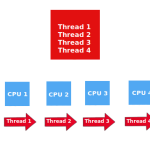
The primary distinction between virtual and physical memory is that physical memory makes reference to the actual RAM of the system connected to the motherboard. Virtual memory, on the other hand, is a technique of memory management that enables users to execute programs that are bigger compared to the actual physical memory.
An operating system’s memory management is crucial. It enables the movement of processes between the hard drive and the main memory while the program’s execution is still in progress. Furthermore, to allocate processes and free up memory, this process monitors the location of every memory. The current storage of programs is in the physical memory, which is the main memory. However, virtual memory expands the capacity of the main memory by utilizing the hard disk to execute huge programs.
Key areas covered
1. What is Physical Memory
2. What is Virtual Memory
3. What is the Difference Between Virtual and Physical Memory
Key Terms
Ram, Main Memory, Virtual Memory, Physical Memory
Physical memory:
RAM (random access memory) is a type of computer data storage that holds currently running programs.
Virtual memory:
Virtual memory is a way of managing memory, which generates the illusion of a bigger physical memory.
What is Physical Memory?
RAM, or primary memory, in a computer, is referred to as physical memory. Physical memory is a type of volatile storage. As a result, data retention necessitates a constant supply of electricity. Nevertheless, power outages and interruptions might cause the deletion of contents in the physical memory. This memory is also linearly addressable. Simply said, memory addresses grow linearly.
The CPU can access physical memory directly. It keeps programs in the execution queue. Typically, applications are stored on a hard disk. It takes longer for the CPU to reach the hard drive to run programs. As a result, the programs are initially stored in physical memory for the CPU to execute them more quickly.
Accessing data via physical memory requires less time than accessing data from an HDD. After the execution finishes, the programs are returned to the hard drive. Similarly, free memory can indeed be assigned to a new application. These programs are referred to as processes when their execution is in progress.
What is Virtual Memory?
Logical memory is virtual memory. Said otherwise, it is a way of managing the memory that the operating system employs. Virtual memory enables developers to exploit more memory for programs than the physical memory available. If the available physical memory is 4GB while the virtual memory is 16GB, the developer can execute the program using the 16GB virtual memory. He can use virtual memory to run complicated applications that need more memory than the available physical one.
Furthermore, by utilizing the hard drive, virtual memory extends the employment of physical memory. It also blocks direct access to the main memory. Moreover, while virtual memory is accessed, its addresses are converted to physical addresses. As a result, virtual memory protects memory.
Difference Between Physical and Virtual Memory
Definition
Physical memory, or RAM, is a type of data storage for computers that stores the programs running at the moment. Virtual memory, on the other hand, is a way of managing memory, which generates the illusion of a bigger physical memory. As a result, that is the primary distinction between virtual and physical memory.
Memory Type
Virtual memory is a conceptual memory, whereas physical memory is real.
Speed
Another distinction between virtual and physical memory is speed. Physical memory outperforms virtual memory in terms of speed.
Technique
Some other distinction between virtual and physical memory is that virtual memory employs paging, whereas physical memory employs the swapping approach.
Size
The capacity of the RAM chip limits physical memory; nevertheless, the size of the hard drive limits virtual memory.
CPU
Physical memory has immediate access to the CPU, whereas virtual memory does not. As a result, that’s still another distinction between the two of them.
Conclusion
The primary distinction between virtual and physical memory is that physical memory corresponds to the system’s real RAM, which holds the presently operating applications, whereas virtual memory is a way of managing memory that allows users to run programs of bigger size compared to the actual RAM.














